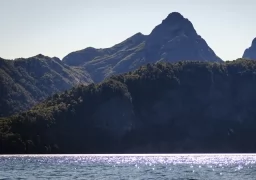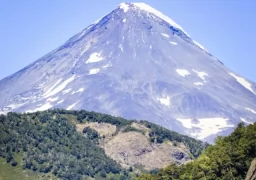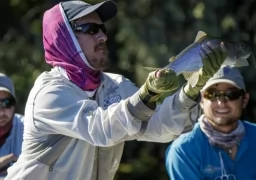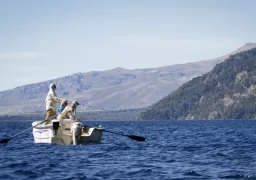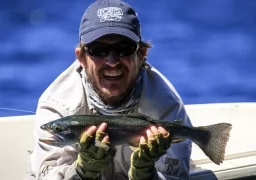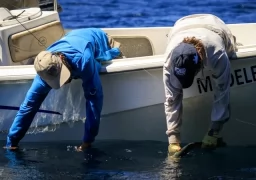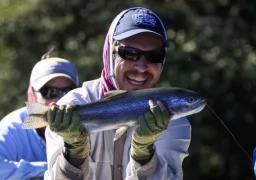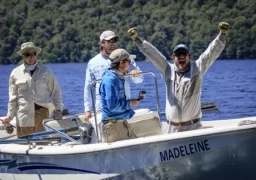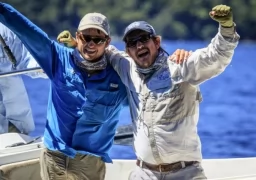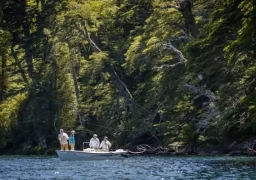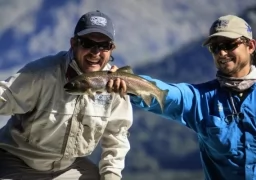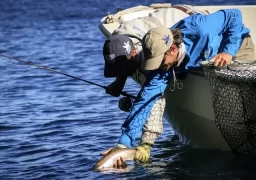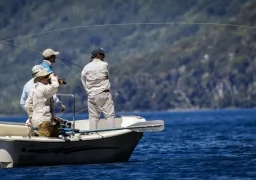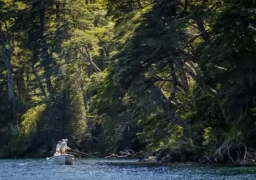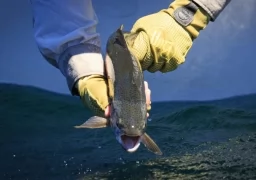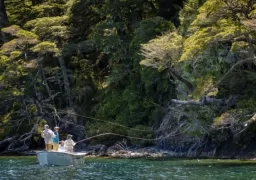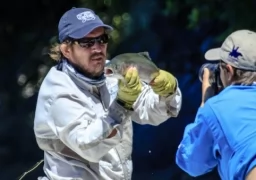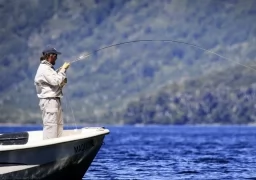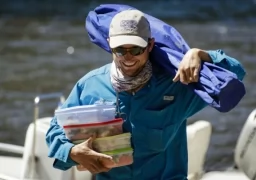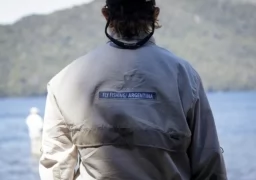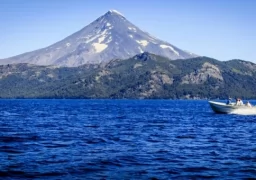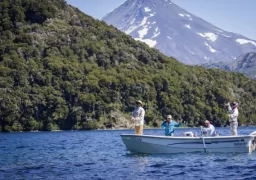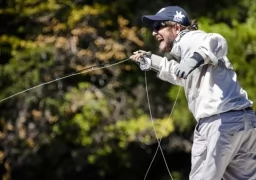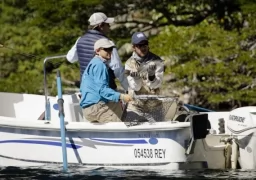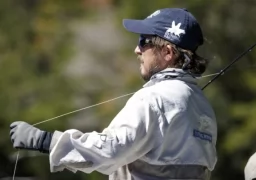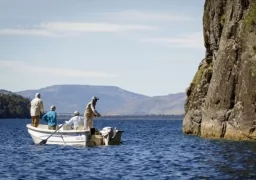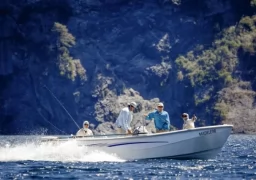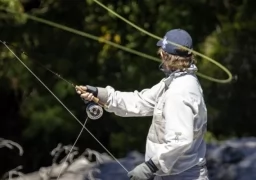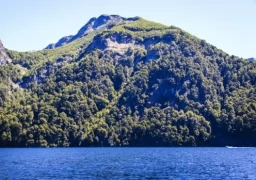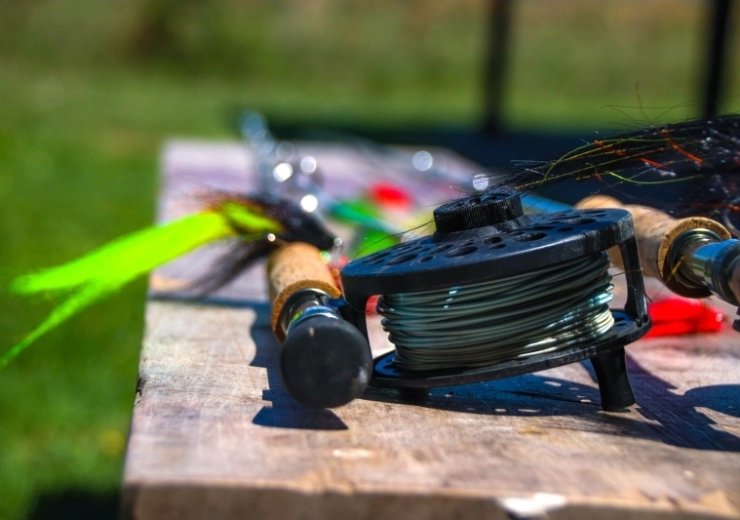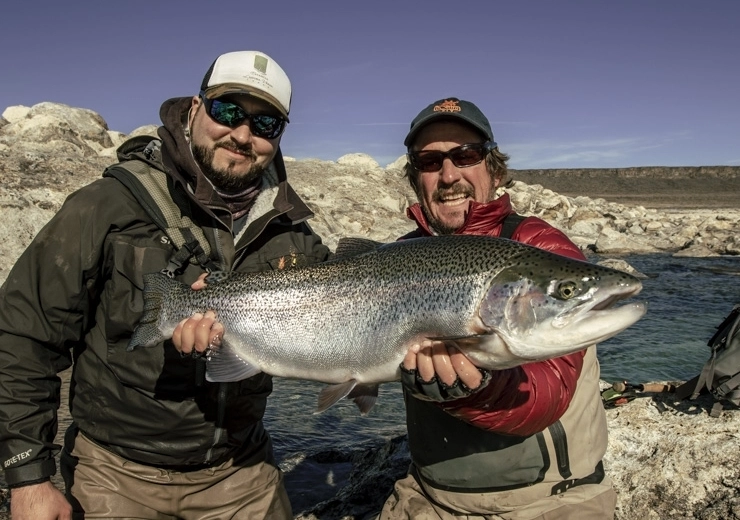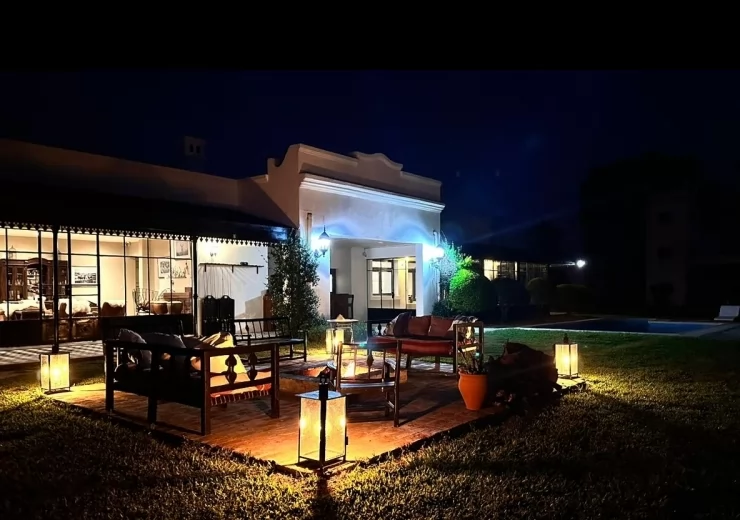NEWS & REPORTS
First day at Tromen Lake
This first day, we left Casona Del Alto Lodge in San Martin de los Andes at about 8: 30 am to the lake on west direction from where we spent the night. It was a beautiful sunny morning. Wind was very slow, probably 15 or 20 km/h. After an hour of driving, we got to the lake at about 9:20 am.
Gonzalo was our main guide, but there was Pepe too as a great guide, and the trouts we have been fishing are Rainbow Trout, Brown Trout and Brook Trout.
The first one is a very special trout, the rainbow trout, also called redband trout, is a species of salmonid native to cold-water tributaries of the Pacific Ocean in North America and Asia.
About appearance, they are torpedo-shaped and generally blue-green or yellow-green in color with a pink streak along their sides, white underbelly, and small black spots on their back and fins.
Rainbow trout usually inhabit well oxygenated, shallow rivers with gravel bottoms; they also inhabit in lakes, although they are usually found in deeper, cool lakes with adequate shallows and vegetation for good production. The ideal temperature range is 50 to 60 degrees. Lake populations generally require access to gravely bottomed streams to be self-sustaining.
The second one, the brown trout (Salmo trutta), is a European species of salmonid fish that has been widely introduced into suitable environments globally.
The first introductions in Canada occurred in 1886 in Newfoundland and continued through 1933. The only Canadian regions without brown trout are the Yukon and Northwest Territories. Introductions into South America began in 1904 in Argentina.
The brown trout is a medium-sized fish, growing to 20 kg (44 lb) or more and a length of about 100 cm (39 in) in some localities, although in many smaller rivers, a mature weight of 1.0 kg (2.2 lb) or less is common.
Within the US, brown trout introductions have created self-sustaining fisheries throughout the country. Many are considered \"world-class\" such as in the Great Lakes and in several Arkansas tailwaters. Outside the US and outside its native range in Europe, introduced brown trout have created \"world-class\" fisheries in New Zealand, Patagonia and the Falklands.
Last but not least, we also went fishing brook trout (Salvelinus fontinalis) is a species of freshwater fish in the salmon family Salmonidae. It is native to Eastern North America in the United States and Canada, but has also been artificially introduced elsewhere in North America and to other continents. In parts of its range, it is also known as the eastern brook trout, speckled trout, brook charr, squaretail, or mud trout, among others. Apotamodromous population in Lake Superior is known as coaster trout or, simply, as coasters. The brook trout is the state fish of nine states: Michigan, New Hampshire, New Jersey, New York, North Carolina, Pennsylvania, Vermont, Virginia, and West Virginia.
The brook trout inhabits large and small lakes, rivers, streams, creeks, and spring ponds. They prefer clear waters of high purity and a narrow pH range and are sensitive to poor oxygenation, pollution, and changes in pH caused by environmental effects such as acid rain.
We were fly-fishing on Tromen Lake, located inside the Lanin National Park and less than 2 hours north from San Martin de los Andes and Chapelco Airport.
This lake is a really special one. It is 1100 mts above sea level and it is a deep waters lake of about 1200 feet deep.
Embarking boat, we head towards the lake bottom where we fished in stone walls.
The day was great since a little wind made some waves which helped us make a closer fly casting. Everything was catch and release and we used fishing rods Siege number 5 and L.L. bean number 5 too, with leading floating lines 4X and attractors flies afloat and fish hooks between 8 and 14.
On this first day of fishing, we used flys like Fat Albert and Turk’s Tarantula. We were also using Simms gloves, neck protector Columbia, Pointer Flyfishing shirts, Simms Wader and Simms wading boots.
At the beginning of the morning, we fished around those stone walls. Although shadows didn’t allow us to see the fish clearly, we had really good results as we fished 2 and 3 pounds rainbow trouts mostly. During the morning we hadn’t any brown trout nut we saw a couple of brooks.
At the end of the morning, we had calm waters so we were able to see the fish, doing some casting to the identification of each one.
Between Pablo and David, 4 fish of about 17 to 20 inches and with great presentation on the flies were caught.
After an awesome morning, we had lunch at the camp, eating salads and omelettes, sitting in the sun and enjoying some cold drinks. An hour later we started the afternoon fishing. It started really hard. There was this really hot weather going on and we were costing like an hour without luck until we could finally start fishing again and, at the end, we caught 5.
As mentioned, we were fishing in San Martín de los Andes, a city in the province of Neuquén, Argentina. It is located in the Lácar Department in the south-west of the province, at the foot of the Andes.
A major change in settlement life came when in 1937 Lanín National Park was created. This meant that wood logging was gradually reduced and numerous small settlements along the lake shore disappeared. New roads were built effectively connecting San Martín with the rest of Argentina.
At present, either for the ski season or the summer, it is a popular destination for tourism, and the seat of the administration headquarters of the Lanín National Park. Its landscape is one of the most spectacular of Patagonia.
Going back to this incredible fishing day, I remember one moment at 4 pm when we were coasting on the rocks and Gonzalo said that he saw a fish 20 mts away from us and made us throw ourselves behind a log that was almost inside the water. The fly fell 40 cm close to where he said the fish was and we saw the trout turning and catching the fly. The success of that catching was thanks to the best guide of San Martin de los Andes, Gonzalo Flego.
ANECDOTE
When you throw the fly and it lands on the water, you make something called “twitch” so the fly moves and then you have to leave it still for a few seconds to attract the fish. In this case, Pablo was a little obstinate, so he did the first twitch, saw the fish coming and not catching the fly, and did a second twitch which pissed Pepe off and so he got really angry ! After several minutes of arguing with Pablo telling him what he did was wrong, we all saw a brooke trout catching the fly, noticing that Pablo was right by proving something impossible for Pepe. After all this discussion, we fished some beautiful fontinalis trouts of about 21 inches.

